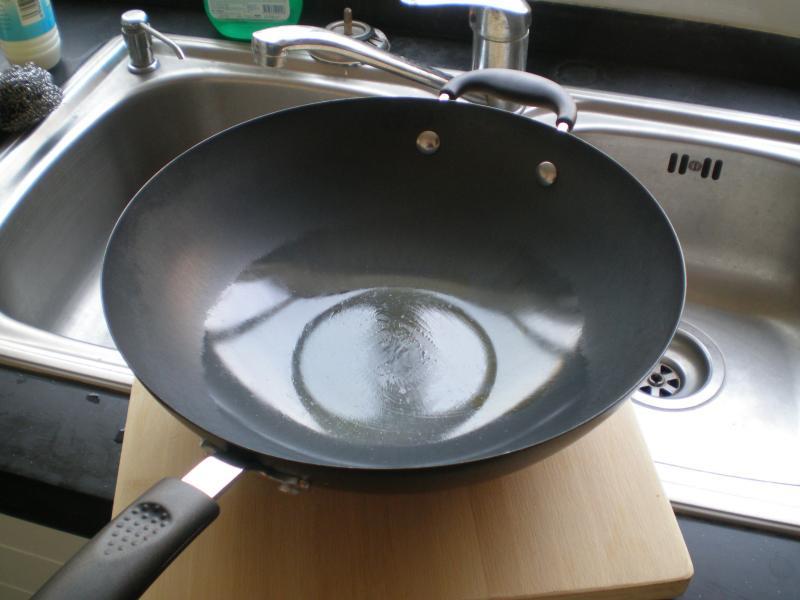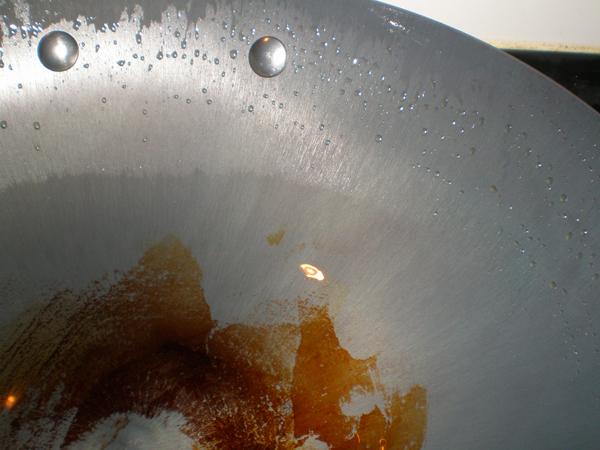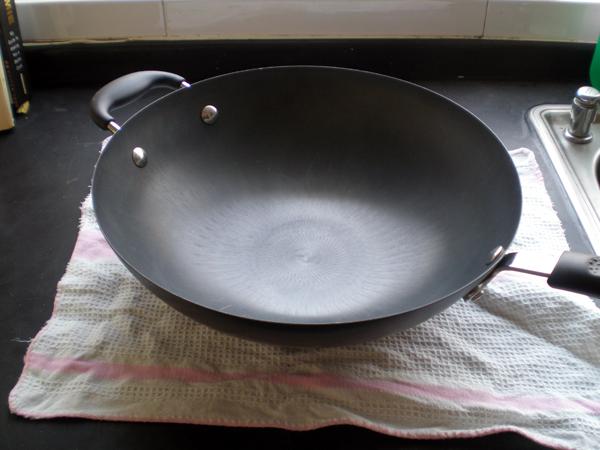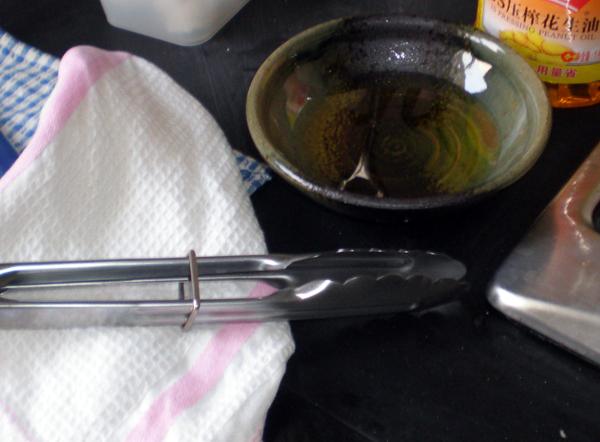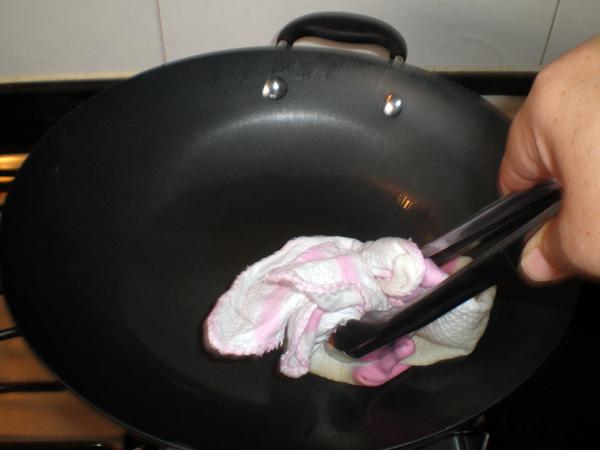-
Posts
3,664 -
Joined
-
Last visited
Content Type
Profiles
Forums
Store
Help Articles
Everything posted by nakji
-
Interesting, Richard. Can you walk us through the basic steps of brewing a cup gong fu style? Right now I'm using a western-style coffee mug and a glass jug for brewing my teas, as I've been holding off buying any special equipment until I know more about what teas I enjoy drinking. Can you gong fu brew any type of tea? If so, could you walk us through a few examples?
-

Revolutionary Chinese Cookbook by Fuchsia Dunlop
nakji replied to a topic in China: Cooking & Baking
I think "enough oil" is pretty vague, and is hard to determine by a closer reading of the recipe. If you'd never deep-fried before, how would you know how much is enough? You could infer that you'd need a greater volume of oil than the one given for chicken, say, but I don't think it would have been difficult for a general quantity of oil for frying to be specified, either. -
I just had a big dinner with some of my co-workers to celebrate Eid - we went to a Uighur restaurant in our neighbourhood and had some seriously good eats. We started with da pan ji, which I found incredibly similar to Andong style jjim ddalk, a Korean dish - except instead of broad noodles, jjim ddalk uses glass noodles. Yum. We also had lamb kebabs (succulent) fried lamb ribs with a dry-spice dip (fatty and fine) and short, gnocchi-like noodles wok-fried with lamb, tomatoes, and beans. We also had a naan bread smothered with ground lamb fried with cumin, cilantro, and carrot shreds. I don't think that dish survived a full revolution around the lazy-susan, now that I think about it. There's another, smaller Uighur restaurant around the corner from my flat, which serves the same kebabs, but also has the carmelised potatoes (OMG, OMG), and does a dry-fried green bean with Sichuan peppercorns. Both restaurants turn out some of the finest comfort food I've found in Asia. What I need to know now is - recipes? Anyone have a good source on learning to make this stuff? The da pan ji I could probably figure out, but I'm interested in those noodles - how are they made? And what's in that spice dip?
-

Revolutionary Chinese Cookbook by Fuchsia Dunlop
nakji replied to a topic in China: Cooking & Baking
Indeed, people in Asia seem to enjoy extracting their meat from bones, while most of my friends and family in North America generally find this task tiresome and prefer fillets, breast meat, etc. I won't attempt the fish recipe here, as I don't think the quality of local fish is very nice. I was raised on ocean fish from the Grand Banks, and river fish from Northern Labrador, so I'm pretty picky when it comes to fish I like. I haven't had much in Asia that I thought was to my taste, except for the odd fish pulled out of a rice paddy in Northern Vietnam. And there, I suspect, it was my hunger that made it so delicious! It's funny you mention the index, Susan, as I don't think I'd even glanced at it once - I take sticky tabs to my new cookbooks, and tab the recipes I want to try right off. If I don't like the recipe, I strip off the tab; otherwise, the recipes stay tabbed. The salted chilis I can buy in the grocery store here, so I hadn't even thought about trying to find a recipe for them. One thing I did notice, however, is that it's probably not a cookbook I'd give to a beginner. I bought this book last July when I was visiting Canada, and my parents requested that I cook the General Tso's chicken for them. You're right Fooey, it was excellent - it's not normally the sort of cooking I like doing at home, since I hate deep-frying, but that's what they wanted. Anyway, the instructions for frying the chicken were pretty basic - -with following instructions on draining the chicken and the oil. Now, I know what she means by deep-fry the chicken, and enough oil, but if I handed this recipe to my husband to cook from, I'd be called back into the kitchen every five minutes from the start of cooking until the dish was done to consult on each step. It's not really meant to be a beginner's book, though, so I don't really have a problem with that. But it's worth keeping in mind before choosing the book. -
I just bought 100g of wulong from the tea shop across the street. The source notes were handwritten, so I couldn't quite take down the information, but it's from the 2009 harvest, from Anxi Fujian province - I suspect it might be a Tieguanyin, but didn't confirm that. I'm enjoying my first infusion - it's very floral and light, with hardly any of the smokiness I usually associate with oolong. I also had my first pu'er tea last week, which was transformational - who knew tea could have such a rich flavour?
-
Well, I didn't think I had, until the blood started. Funny thing was, it didn't even hurt that much. I ruined a dishtowel, though.
-
I will never again use the blade of my cleaver to carry ginger to the wok, and take off said ginger by running my fingers over the edge. Who knew fingers had so much blood?
-
I made two dishes; first, I steamed it briefly -about five minutes - and then stir-fried with yard-long beans. I cubed some more, added it to a 2:1 ratio of glutinous rice and short-grain rice, along with five or six reconstituted and sliced dried mushrooms. I used some of the mushroom liquor and a slug of dark soy sauce in the water, in a riff on takigomi-gohan. Both dishes came out succulent, and re-heated brilliantly for lunch today. It will be bought again, along with the more ham-like cut, which I plan to stir-fry with garlic chives.
-
I picked up this book before moving to China in hopes of having a few recipes I could turn out for dinner during the week. While there are several more ambitious dishes included (the yolkless egg with shiitake mushrooms comes to mind), I was happy to find lots of easy dishes with clear instructions. I've tried Mao's red-braised pork a couple of times, such that the page is completely spattered with brown sauce and grease from having been too close to the burner when the water went in the caramel. On Sunday, I made beef with cumin from page 102 - an exceptional success, and not more than thirty minutes from prep to plate. Alongside, I made the coriander salad from page 59 - fresh, simple, and green, adjectives which perhaps not a lot of people associate with Chinese food. Perfect home-cooking, however. While the design and the intros to recipes in the book give a real sense of place, it does suffer from something that a lot of other Chinese cook books do as well. [minor rant] The Chinese characters used in the recipe titles are traditional, and are accompanied by pinyin without the tones. So if you can't read the characters, you can make sounds in Chinese that have no meaning to Chinese people, but are pronounceable by anglophones? Why bother putting in pinyin without any guidance to the tones? I'm sure, of course, that this book is not meant to be used as a language source, but it's frustrating for me to try and describe either what I've made (to my Chinese friends) or what I'm trying to make(to the butcher or shop owner, while trying to get an ingredient) and have an incomplete set of information to work from.[/minor rant] I'm not hugely bother by this, and it's a point that can be gotten around by bringing the book to the market with me (tedious) or having my husband copy out the characters (useful only to the extent he knows them), but it's worth showing my support on paper, if you will, for the use of proper, toned pinyin in Chinese cookbooks. We wouldn't expect to see a French cookbook leaving off the accents aigu and grave, why lose the tone markers on pinyin?
-
Pepsi Shiso????? That's...really stretching for a new flavour, I think. I miss the seasonal changing of the Koiwai Farms drinks. The apple was great, and grape and orange were a mainstay, but then they also had peach, fruit punch, apricot, western pear...has anyone seen any new ones lately? And don't even get me started on the good work done by the fine people of Kirin's World Kitchen drink division. The mascarpone coffee, the salt caramel latte....*sigh.
-
Folding is clearly the way to go with a maladroit like me. It just makes so much sense. Keep the vegetables on the outside, leave the queso in the tortilla, which solves the sticking problem altogether. I shall adapt. I guess what's bugging me is that the first time I saw quesadillas (I'm from rural Canada) was in Martha Stewart, and she used two tortillas, stuffed with veg and cheese, and the bloody things came out perfect. Of course. I definitely pre-cook my peppers and the like. What I have a problem with is getting those peppers to adhere to the cheese which then should adhere to the other tortilla. I suspect that either a) I'm not using enough cheese (cheese is very expensive where I live, so I tend to skimp) b) I'm using too much of the "other" ingredients, or c) all of the above, plus bad methodology. Current method: I heat my tortillas in the pan first, then put down some cheese on one, plus peppers, wait for the cheese to semi-melt, then pop another on, wait another minute or so (on low heat), then try to flip it. Invariably, the vegetables come tumbling out the sides. From now on, I shall fold.
-
I wasn't that tempted, except for cooking wine! Thanks for this informative reply. I'll be in Shanghai in October, and I'll definitely check out your recommendations. I'll set up some delivery then. I'm not a serious wine drinker - I don't have a cellar or anything - but when I drink wine, I like to have a decent bottle. There is a certain charm in some Asian wine - when I lived in Vietnam, we used to enjoy a bottle of Vang Da Lat when we had a nice Vietnamese meal. I'd never consider it in the same league as European wine, but it did complement the meal, which, at the end of the day is the goal, I suppose. By the same token, when I visited Beijing, oh-so-briefly a couple of years ago, we went for duck - of course! (Not at Quanjude ) We had a local bottle then, too. I can't recall the name, but it was quite light, with a cherry taste that kind of reminded me of Beaujolais. It went well with the duck, and I was quite happy with it. Do you think domestic wine pairs better with Chinese food than imported wines? And do you think it's worth pairing European/New world wines with Chinese food? The restaurant we went to last night had a selection of Chilean wines with recommendations for their featured dishes - a Pinot Noir with a spicy claypot chicken, if I recall correctly, and a Chardonnay for a rice and pork dish with bitter melon. What's been your experience with this?
-
Fuschia Dunlop calls for steaming it before frying it as well. Should I cut it, then steam it, or steam it in a chunk, then slice? I had a dish at a restaurant last night which was the cured ham stir-fried with garlic chives - unbelievable! It was spectacular. I get home, and sure enough, Ms. Dunlop has a recipe for it in "revolutionary cooking". Except she cuts hers with a little smoked tofu, which I'm not a huge fan of.
-
This challenge brings to mind an excellent drink I used to enjoy in Seoul. Take equal parts Yakult and Chamisul soju, stir together, and drink until the styrofoam ring bar snacks start to taste good. Actually, the sweetness in the yogurt and the soju complement each other nicely. It's not a very glamourous drink, however. It should be served in a small pitcher, ideally one re-purposed from some other kind of alcohol bottle and poured into sake cups, soju glasses or other similar-sized vessels.
-
Shanghai HAS A CITY SUPER???!!! /sound of running feet and a door slamming/ I've been to one ex-pat market in Shanghai - just under the Sheraton on Nanking road, I think. Lots of muesli, a spotty Thai section, reasonable Japanese selection (meaning more than just one kind of miso)but a selection of your average Belgian beers - Leffe blond/brun, a couple of Chimays, and Stella, of course. I was impressed because they actually stocked a couple of Japanese microbrews - Ginga Kogen is the one I remember seeing. If I recall correctly, the booze section here was as big as the food section. As for cheese and charcuterie...uh, not so much. Some imported Australian dairy, though . No plain yogurt. As for Indian spices, I have an e-mail address given to me by one of my co-workers. There's a supplier who deals with the local Indian community in SH who will deliver. Another good strategy is to go find a mosque, and see what the shops around there sell. That's what I did in Seoul.
-

Vietnamese Bun Cha - Bun Thit Nuong Difference
nakji replied to a topic in Elsewhere in Asia/Pacific: Cooking & Baking
My friend's lady on the street in Hanoi swears the bun cha dipping sauce is only green papaya (cut into small flat green squares, not shredded) a little vinegar and water. There's probably MSG in there, too, actually, now that I think about it. The dipping sauce in Hanoi is always a tinge brownish, so I couldn't entirely rule out a little diluted caramel sauce. But word on the street swore it was only three ingredients. -
Right, say what you will about American cultural hegemony, but one of its great benefits is being able to buy Old El Paso products throughout Asia. Yes, handmade ones are better, but those in the dine-and-dash topic will agree there are times when convenience and speed are needed. Last night, I cam home from a murderous day at work, pulled out the shame tortillas and attempted to put together some quesadillas for dinner. Now, I've never really had a recipe for these, and since they're not too far off from a grilled cheese sandwich, I never bothered to look for one. But last night, standing in the middle of fall-out radius covered with pepper strips, corn, and half-melted cheese shreds, holding a pan with two blackened tortilla discs resting on a middle layer of unmelted cheese, it occurred to me that I might need some help. I'm okay if the middle only has to hold cheese - I can manage that. But adding anything else - I can't get it to hold together. What's your best method for stuffing quesadillas?
-
That recipe in Tuesdays with Marcella is (of course) a Marcella Hazan recipe from "Marcella's Italian Kitchen". I highly recommend it, as it makes excellent pickles for a sandwich or antipasti platter. I have even packed them into bento boxes with cheese and cold cuts. I usually use rice vinegar, as it's what I have on hand, but I believe Marcella calls for 1 cup of red wine vinegar for her method. I can't recommend this recipe enough!
-
Well, this just begs the question then! What are your recommendations for duck in Beijing? And why is Quanjude bad?
-
I like a nice glass of wine, especially on a Friday night after work. I had a look at some bottles available in my local area, and found the imported wine section to be sickly and overpriced. Basically, bottles of Blue Nun going for around the equivalent of $20. I have no intention of swearing off wine, so I'm considering purchasing something local - there seems to be a large selection of domestic, European-style wines available, but I have no idea how to guess what might be drinkable or not. I think most of the local product is red - I generally prefer lighter red wines such as a pinot noir. What sort of bottles, if any, should I be considering?
-
Hear hear! A lot of times I view tea as a means to fuel me through work, where volume is more important than quality. It's worth remembering that a fine cup of tea (or coffee, for that matter) provides an opportunity for a mental refreshment as well. Stepping away from my desk and taking a minute to brew and enjoy a decent cup allows me to not only appreciate the quality of the tea, but the ritual of making the tea itself provides a respite from other tasks. If I can do it reasonably well, to turn out a reliably good cup of tea and to find five minutes to myself, then I think the effort is well-spent.
-
Lots of fabulous suggestions! Of course - I'll try it stir-fried with some vegetables, but I'm also curious about cooking it with rice. Duck liver sausage is available, as the Wal-mart in question is a brand new one in Suzhou, Jiangsu province, where I'm currently living. It's quiteexcellent, but I concur with the exhaustion. When I get home I feel like I've run a marathon. Yes! yesyesyesyes! My husband came home with some fresh, hand-made noodles, and I had no idea what to do with them, nor appropriate means to deal with them, so I had to bin them. I felt like an utter failure. As for the "glutinous" rice, are we talking the kind of rice that's usually used to make rice cake/mochi? The kind that's more of an opaque white colour than typical rice? Then, would I saute the meat and add it to already cooked rice, or can I cook it in with the rice as it cooks, like a Japanese-style takigomi-gohan?
-
Ms. Tropp suggests this step be repeated two or three more times, with the pan cooling between onslaughts of oil. I repeated the rubbing until I got a good colour on the bottom of the pan, and oil began to bead up and run down in rivulets along the side. You can also see how it seems to have a small shiny area on the bottom. As I use it to cook, I hope the dark shiny area will build. After two week's use, I'm already getting a nice colour there, and food is sliding around nicely on the bottom of the pan. I shall never use soap on it, and I'm emptying it out immediately after use, but Barbara is very anti-wok brush. I'm wondering, though, if I use the wok everyday, with it stand up to some light abrasive, like a bamboo brush?
-
I bought my first wok a couple of weeks ago from a supermarket here in China. It's 32 cm, and flat-bottomed. I didn't see any round-bottomed woks available for purchase. Actually, when I bought it, I joined a rather large group of confused looking locals surveying the racks - it seems the main qualification for purchase was the ability of the shopper to heft and brandish the wok appropriately. At one point, an older man got so animated with his pan that he brought down an entire row of woks upon himself - it was fun to watch all the shop attendants come running to rescue him from the pile. It must be a thorny choice for people, because as I was making my way through the store with my wok in the basket, my friend and I were stopped by another woman who asked us how we'd managed to pick one out - she confessed there were too many models for her to choose from. The shop attendants were keen to push non-stick woks on us, but I wanted one to season myself, following Barbara Tropp's thorough method listed in her "Modern Chinese Cooking", which I will chronicle in photos here. First; the wok. I think it's carbon steel, but who knows. Ms. Tropp is very specific that it gets a good scrubbing, but minutes of furious scrubbing yielded me a pan no different than before the steel wool touched it. I assume she was dealing with dirtier pans in her day. Still, she doesn't strike me as the sort of person whose steps should be skipped. So; I scrubbed. Then, onto the gas ring on a high heat, until the pan sizzled water. I had a dish of peanut oil, tongs, and a cloth to help. She suggests paper towel, but I couldn't find any. When the pan was hot enough to sizzle water, I began to rub in the peanut oil with the cloth, until the pan began to smoke and turn dark on the bottom. Not for those faint of heart or exhaust. Fortunately, Chinese home kitchens seem to be well ventilated.
-
The sick thing is - it was a Wal-mart. Anyway, if it's lop yuk, I'll look that up in my small Chinese cookbook library, and see what else I can make with it. Steamed into rice might make my husband more inclined to eat rice, actually.


